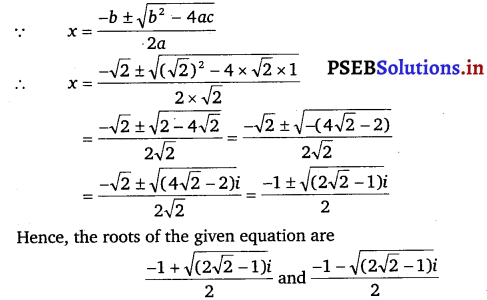Punjab State Board PSEB 11th Class Maths Book Solutions Chapter 5 Complex Numbers and Quadratic Equations Ex 5.3 Textbook Exercise Questions and Answers.
PSEB Solutions for Class 11 Maths Chapter 5 Complex Numbers and Quadratic Equations Ex 5.3
Question 1.
Solve the equation x2 + 3 = 0
Answer.
The given quadratic equation is x2 + 3 = 0
On comparing the given equation with ax2 + bx + c = 0, we obtain
a = 1, b = 0, and c = 3
Therefore, the discriminant of the given equation is
D = b2 – 4 ac
= 02 – 4 × 1 × 3 = – 12
Therefore, the required_solutions are
\(\frac{-b \pm \sqrt{D}}{2 a}=\frac{\pm \sqrt{-12}}{2 \times 1}=\frac{\pm \sqrt{12} i}{2}\) [∵ √- 1 = i]
= \(\frac{\pm 2 \sqrt{3} i}{2}\) = ± √3 i.
![]()
Question 2.
Solve the equation 2x2 + x + 1 = 0.
Answer.
The given quadratic equation is 2x2 + x + 1=0
On comparing the given equation with ax2 + bx + c = 0, we obtain
a = 2, b = 1 and c = 1
Therefore, the discriminant of the given equation is
D = b2 – 4ac
= 12 – 4 × 2 × 1
= 1 – 8 = – 7
Therefore, the required solutions are
\(\frac{-b \pm \sqrt{D}}{2 a}=\frac{-1 \pm \sqrt{-7}}{2 \times 2}\)
= \(\frac{-1 \pm \sqrt{7} i}{4}\) [∵ √- 1 = i]
Question 3.
Solve the equation x2 + r + 9 = 0
Ans.
The given equation x2 + 3x + 9 =0
On comparing the given equation with ax2 + bx + c = 0, we obtain
a = 1, b = 3, and c = 9
Therefore, the discriminant of the given equation is
D = b2 – 4 ac
= 32 – 4 × 1 × 9
= 9 – 36 = – 27
Therefore, the required_solutions are
\(\frac{-b \pm \sqrt{D}}{2 a}=\frac{-3 \pm \sqrt{-27}}{2(1)}\)
= \(\frac{-3 \pm 3 \sqrt{-3}}{2}=\frac{-3 \pm 3 \sqrt{3} i}{2}\) [∵ √- 1 = i].
![]()
Question 4.
Solve the equation – x2 + x – 2 = 0.
Ans:
The given quadratic equation is – x2 + x – 2 = 0
On comparing the given equation with ax2 + bx + c = 0, we obtain
a = – 1, b = 1, and c = – 2
Therefore, the discriminant of the given equation is
D = b2 – 4ac
= 12 – 4x(- 1) × (- 2)
= 1 – 8 = – 7
Therefore, the required solutions are
\(\frac{-b \pm \sqrt{D}}{2 a}=\frac{-1 \pm \sqrt{-7}}{2 \times(-1)}=\frac{-1 \pm \sqrt{7 i}}{-2}\) [∵ √- 1 = i]
Question 5.
Solve the equation x2 + 3x + 5 = 0
Answer.
The given quadratic equation is x2 + 3x + 5 = 0
On comparing the given equation with ax2 + bx + c = 0, we obtain
a = 1, b = 3, and c = 5
Therefore, the discriminant of the given equation is
D = b2 – 4ac
= 32 – 4 × 1 × 5
= 9 – 20 = – 11
Therefore, the required solutions are
\(\frac{-b \pm \sqrt{D}}{2 a}=\frac{-3 \pm \sqrt{-11}}{2 \times 1}=\frac{-3 \pm \sqrt{11 i}}{2}\) [∵ √- 1 = i].
![]()
Question 6.
Solve the equation x2 – x + 2 = 0
Answer.
The given quadratic equation is x2 – x + 2 = 0
On comparing the given equation with ax2+ bx + c = 0, we obtain
a = 1 , b = – 1, and c = 2
Therefore, the discriminant of the given equation is
D = b2 – 4ac
= (- 1)2 – 4 × 1 × 2
= 1 – 8 = – 7
Therefore, the required solutions are
\(\frac{-b \pm \sqrt{D}}{2 a}=\frac{-(-1) \pm \sqrt{-7}}{2 \times 1}=\frac{1 \pm \sqrt{7} i}{2}\) [∵ √- 1 = i]
Question 7.
Solve the equation √2 x2 + x + √2 = 0
Answer.
The given quadratic equation is √2 x2 + x + √2 = 0
On comparing the given equation with ax2 + bx + c = 0, we obtain
a = √2, b = 1, and c = √2
Therefore, the discriminant of the given equation is
D = b2 – 4ac
= 12 – 4 × √2 × √2
= 1 – 8 = – 7
Therefore, the required solutions are
\(\frac{-b \pm \sqrt{D}}{2 a}=\frac{-1 \pm \sqrt{-7}}{2 \times \sqrt{2}}=\frac{-1 \pm \sqrt{7 i}}{2 \sqrt{2}}\) [∵ √- 1 = i]
![]()
Question 8.
Solve the equation √3x2 – √2x + 3√3 = 0
Ans.
The given quadratic equation is √3x2 – √2x + 3√3 = 0
On comparing the given equation with ax2 + bx + c = 0, we obtain
a = √3, b = – √2, and c = 3√3
Therefore, the discriminant of the given equation is
D = b2 – 4ac
= (- √2)2 – 4(√3)(3√3)
= 2 – 36 = 34
Therefore, the required solutions are
\(\frac{-b \pm \sqrt{D}}{2 a}=\frac{-(-\sqrt{2}) \pm \sqrt{-34}}{2 \times \sqrt{3}}\)
= \(\frac{\sqrt{2} \pm \sqrt{34} i}{2 \sqrt{3}}\) [∵ √- 1 = i]
Question 9.
Solve the equation x2 + x + \(\frac{1}{\sqrt{\mathbf{2}}}=\) = 0
Ans.
We have, x2 + x + \(\frac{1}{\sqrt{\mathbf{2}}}=\) = 0
√2x2 + √2x + 1 = 0 …………….(i) [multiplying both sides by √2]
On Comparing eq. (i) with ax2 + bx + c = 0, we get

![]()
Question 10.
Solve the equation x2 + \(\frac{x}{\sqrt{2}}\) + 1 = 0
Ans.
The given quadratic equation is x2 + \(\frac{x}{\sqrt{2}}\) + 1 = 0
The equation can also be written as √2x2 + x + √2 = 0
On comparing the given equation with ax2 + bx + c = 0, we obtain
a = √2, b = 1, and c = √2
∴ Discriminant(D) = b2 – 4ac
= 12 – 4 × √2 × √2
= 1 – 8 = – 7
Therefore, the required solutions are
\(\frac{-b \pm \sqrt{D}}{2 a}=\frac{-1 \pm \sqrt{-7}}{2 \sqrt{2}}=\frac{-1 \pm \sqrt{7 i}}{2 \sqrt{2}}\) [∵ √- 1 = i]
